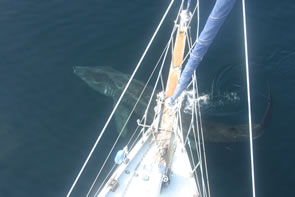Species Index

Key Facts
Length: Up to 11 metresRange: Widely distributed in cold to temperate waters
Threats: Marine litter, entanglement in fishing gear, pollution, boat strikes, hunting
Diet: Plankton

Basking Shark
Latin: Cetorhinus maximus
Gaelic: Cearban
Physical Description
The basking shark is the second largest fish in the world; only the whale shark is bigger. When fully grown it can measure 11 metres in length and weigh about 4500 kg; females are usually slightly larger than males. They have a narrow, pointed and upturned nose, and a huge mouth that can measure up to one metre across. There are five long gill slits that almost encircle the head and, when the mouth is open, the bright white colour of the cartilage between each slit is highly visible. Inside the mouth are up to 1500 tiny teeth, which are not used for feeding but are thought to be useful for grasping their partner during mating. The eyes are relatively small. The triangular dorsal (back) fin can measure up to two metres tall and may flop over to one side in large animals; photographs of the dorsal fin are used to identify individual sharks. Pectoral (side) fins are large and angular, and the caudal (tail) fin is quite long, often notched and moon-shaped. Overall, basking sharks are a dark, slate grey colour with some mottling along the back, they usually bear some scars, and have a paler belly. The skin is covered in denticles (scales) that can feel very rough to the touch and the body may have external parasites, such as the lamprey fish that attaches itself with its sucker mouth. When the animal is seen swimming slowly at the surface, or ‘basking’, the dorsal fin, and often the tip of the nose and the tip of the tail fin, will break the surface as the animal swims. Life expectancy may be at least 50 years.
Habitat and Distribution
Basking sharks are found globally in the cold to temperate waters of all the oceans. They appear to favour coastal waters during spring and summer months and are thought to move into deeper waters during the winter, diving to depths of up to 900 metres to feed on plankton. In the Hebrides, basking sharks are frequently encountered between May and October and are seen in higher numbers around the islands of Coll, Tiree and Mull. Seasonal distribution is related to prey availability, and zooplankton can be highly concentrated in areas of ocean mixing. Research conducted by HWDT shows that basking shark sightings have increased in recent years; further research will help us to understand basking shark distribution in the Hebrides.
Behaviour
Basking sharks normally swim at between 2.5 to four mph, although they are capable of greater speeds to allow them to leap clear of the water (breach), a behaviour that has been recorded around the UK. It is suggested that breaching may help to dislodge parasites from the skin, may form part of a courtship display or might function to create a loud noise for communication with other sharks. Basking sharks give birth to live young; it is thought that the developing pups feed on unfertilised eggs and/or their siblings. Feeding and breeding appears to occur during the summer, and animals migrate to deeper waters for the winter. They are usually seen alone or in pairs, although aggregations of many animals may occur where plankton is plentiful. They do not tend to approach vessels; rather they tolerate approaches made towards them. From satellite tracking studies of individual animals we know that they can be very wide ranging; one animal was tracked from the English Channel up to the Hebrides, covering 1167 miles in 77 days.
Food and Foraging
Swimming at up to four mph with its huge mouth wide open, a basking shark can filter the equivalent of a 50 metre Olympic-sized swimming pool in one hour; that’s 2.5 million litres of seawater passing over the gills each hour. Food items, including small copepods (a species of zooplankton), barnacles, decapod larvae, fish eggs and deep-water oceanic shrimp, are caught on modified, comb-like gillrakers and are swallowed when the mouth closes. The frequency at which they close their mouth to swallow depends on the concentration of prey in the water. Basking sharks are capable of detecting areas of highly concentrated zooplankton prey, which maximises the effectiveness of their foraging.
Status and Conservation
Basking sharks have been hunted around the globe for their fins and for valuable liver oil. Comprising as much as a quarter of the total body weight, the liver is full of oil (squalene) that was previously used as an industrial lubricant and as lamp oil, and now has uses in cosmetics. Between 1947 and 1995, basking sharks were hunted in Scotland and the last of these fisheries (based in the Firth of Clyde) closed down as recently as 1995. Basking sharks continue to be hunted in some countries, mainly for their dorsal fins which are considered a delicacy in Asian countries when served as shark fin soup. Basking sharks are slow to mature and have a long gestation period, which means the species is slow to recover if populations are rapidly depleted. Another threat to basking sharks is harassment by, and collision with, boats. A further threat is entanglement in fishing gear, which can cause injury from nets cutting into skin or causing damage to the dorsal fin, and may result in death if the animal cannot free itself. Basking sharks in UK waters are protected, principally under Schedule 5 of the Wildlife and Countryside Act (1981) and the Nature Conservation (Scotland) Act 2004.





